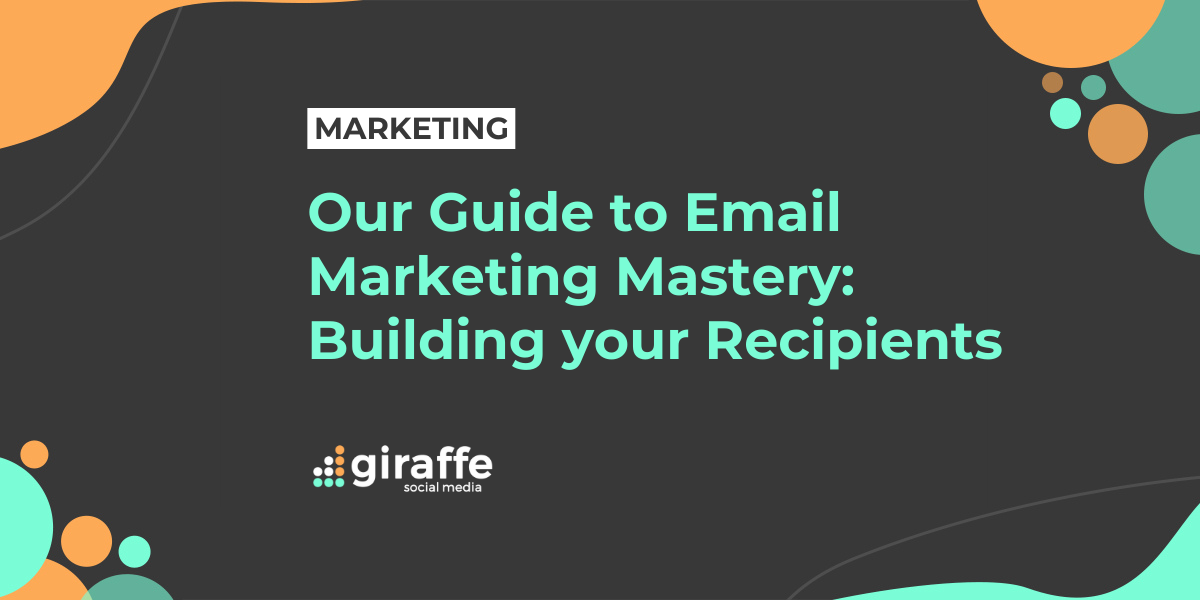Building Your Email Marketing Recipients
1. Follow email marketing regulations
2. Gain sign-ups
3. Avoiding spam filters
4. Set delivery expectations
Email marketing should be an integral part of most digital marketing strategies. On average, email marketing “drives an ROI of $36 for every $1 spent, higher than any other channel,” making it a crucial channel for most businesses. We created our guide to Email Marketing Mastery to give you a better grasp of the finer details of email marketing and help you tap into your business’s true potential. In this instalment, we’re guiding you in building your email marketing recipients, as well as how to maintain your recipient list.
It’s unlikely that you’ll succeed in email marketing if you don’t first build a healthy database of relevant recipients. The best way to do this is to get people to sign up manually, as this means they would already have an established relationship with, or at least knowledge of, your business. This way, they know who you are and what you offer before they receive your emails.
However, if you decide to buy or rent a mailing list, legally you need to check with the supplier to ensure you have the right to use it for email marketing. This is especially important to comply with modern GDPR and email marketing regulations.
Follow email marketing regulations
In accordance with email marketing regulations, you are “only allowed to send marketing emails to individual customers if they’ve given you permission,” and “every marketing email you send must give the person the ability to opt-out of (or ‘unsubscribe from’) further emails.” Essentially, you must have explicit permission from users to send marketing emails (and other marketing communications, which must be specified to the user). You can use the Email Preference Service to check that you’re not sending emails to users who’ve asked not to receive them.
Gaining sign-ups
One of the most trusted ways to grow your email list is through visitors to your website. Use email sign-ups as a call-to-action (CTA) for landing pages, blog content, and other areas on your website to generate sign-ups.
If you create engaging blog content, include a link to email sign-ups alongside the author line and/or at the bottom of the article. Use links to offers and giveaways that require sign-ups to take advantage of web hits. You can also create a free resource or tool such as an e-book exclusive to subscribers to encourage sign-ups. You can then promote these as part of your social media strategy, alongside other offers that require an email address submission.
Create a CTA button for sign-ups at the top of your Facebook page or in the description of your YouTube content. Promote/sponsor the posts, so that they reach a new part of your audience too, so you’re not just targeting people that may already have signed up. Using Facebook’s ads manager, you could even track who’s been on the website, so you can target them too.
Don’t forget about Instagram! While you can’t share links within captions, you can update your bio link with a multi-link card that includes your newsletter sign-up link, and redirect users to your bio at the end of every post caption. Remember, Instagram is now adding link stickers to stories, in favour of the swipe-up link, for users of all follower sizes, so utilise this feature for promoting your newsletter on stories!
Avoiding spam filters
Most renowned email providers work hard to ensure your emails aren’t blocked by ISPs; however, some emails still fall into the junk folder sometimes. To safeguard your content from spam filters and guarantee that you end up in the recipient’s inbox, you need to avoid the spam folder.
RareLogic suggests taking 12 steps to make sure your emails aren’t going into your recipients’ spam folders:
- “Ask subscribers to whitelist your email address,
- Always get permission to send emails,
- Follow the laws governing email marketing,
- Use a reputable email marketing program,
- Proofread your emails,
- Don’t write spammy subject lines,
- Purge abandoned email addresses from your list,
- Use a spam-checking tool,
- Have a clear, identifiable sender address,
- Email your subscribers regularly,
- Make it easy to unsubscribe,
- And be honest.”
One way to get ‘whitelisted’ – aka, into your recipients’ address books – is to include a reminder at the top of each email you send, especially in the initial follow-up email, asking them to add your email address to their contacts.
Using merge tags to address your content specifically to the recipient’s first name (and last name if you want), e.g. “Hello *|FNAME|*”, is a good measure to take and adds a personal aspect to your email. However, this does require you already having first name information in your database, so you may want to consider making names a mandatory section of your sign-up forms.
Set delivery expectations for recipients
As you build your recipient list you need to set expectations for the frequency and quality of emails that you will be sending, and you need to stick to these if you want to retain subscribers. If your subscribers are told that they are signing up for a monthly newsletter, but you instead send weekly marketing emails about your offers, you’ve breached their trust and will likely lose subscribers.
Plan your email marketing efforts in advance and stick to a schedule as much as possible, but also don’t be afraid to experiment with which days and/or times you send your emails. Some email marketing platforms even offer an AI-powered service that recommends a send time based on data from similar companies to you.
That’s all for part two of our Guide to Email Marketing Mastery discussing building your email marketing recipients. Check out part three next for advice on constructing your email campaign, including how to craft a great message and guidance on the structure & design of your email.
Or, head back to part one for a refresher on email marketing, where we gave you an idea of what you should do before you begin your email marketing efforts, outlined why it’s still a relevant form of digital marketing, and explained the legalities surrounding email marketing.
Editor’s note: This article was originally published in October 2019 and has been updated for accuracy and relevance in August 2021.






